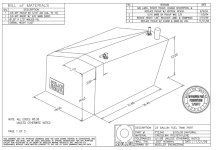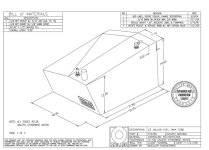Edit: I see Sunbeam has already posted her information on the tanks..While I was having lunch..
The replacement of fuel tanks is a fairly easy project. A number of us can talk you thru it. Moeller makes a take which is 23 gallons, and is made in the port and Starboard side configurations. I have the Moeller, which is 25 gallon (measured buy fill up). The 23 gallon was developed because of the floor which is in the most recent boats. I have the removable floor, which does not affect the tanks.
The best advice about core penetration is to pull the tanks, and then test the core, by drilling out the screws which hold the batten or straps in place. If it is wet, when you drill out--then further investigation is necessary. If there is moisture, as indicated by a moisture meter, then you may want to do some test holes, (which can be easily filled with thickened epoxy) to determine the extent of the damage (don't drill thru the bottom of the boat!)
If the boat is kept out of the water, and covered--not subject to free, thaw, with water in the bilge etc--it is unlikely that there is significant core degeneration.
When you put in the new tanks, you should glass in new battens to hold the tanks in place, and any screws should go into these battens, instead of the hull.
Now as to if ethanol and gas are destroying your tanks:
Coast Guard did a two year long test on plastic fuel tanks and found that gasoline alone and gasoline with alcohol had no measurable affect on plastic tanks.
Gasoline is a blend of multiple hydrocarbons. For the most part polyethylene is very resistant to these chemicals, as it is to ethanol, (and other alcohols).
Certainly fiberglass tanks are attacked by gasoline and ethanol. There is little evidence that this occurs in plastic tanks (Polyethylene in this case).
I would pull the tanks, completely empty them, and then clean them. If there is sign of deterioration, then certainly replace. If not deteriorated, then you can put them back in, with the new battens and straps.
Sunbeam has both posts and information in her photo album which show excellent information on replacement.
As for cleaning. I have used hot water, soap, with pebbles in the tanks, sealed them, and then tumbled for some time. I have also used a medium pressure--pressure washer. Some steam clean, but too much heat can damage the tank. I do regularly "polish" the fuel--at the beginning of a season--this involves a fuel pump, 10 micron Racor filter, and some tubing--takes about an hour for each tank to recirculate the fuel and pretty much remove any material from the fuel which is in the tank. .
Also, when were your fuel lines replaced? They can be a source of the problem.


